History
The history of 3rd Infantry Division is rich and deep
3rd Infantry Division Museum
158 Cavalry Way, Fort Stewart
GA 31314
(912) 767-7885
Tue – Fri, 9:00 AM – 4:00 PM
First Saturday of every month from
10:00 AM – 4:00PM
NOTICE
Located Behind the Main Post Chapel
The Beginnings
While the earliest peoples on Fort Stewart were the Native Americans, who settled the Western Hemisphere about 15,000 years ago, Great Britain established the Georgia colony as a buffer between her Carolina colonies to the north and her enemy the Spanish in Florida to the south. Oglethorpe established the first European settlement in the Fort Stewart area with the 1733 construction of Fort Argyle, in present day Bryan County on the west bank of the Ogeechee River. Its purpose was to raise the alarm in case Spanish or hostile Indians should move to attack the fledgling settlement of Savannah. It is ironic that the first European settlement of the Fort Stewart area was, in fact, a military fortification.
A garrison of Rangers and militia garrisoned the fort intermittently until its final abandonment in about 1770. In the mean time, there were few colonists willing to settle the wilderness of the Fort Stewart area, although by 1768 there was a small settlement at Taylors Creek. The Hunter Army Airfield area also had settlements on the Little Ogeechee River, possibly as early as the 1750s.
By the late 1930s a few thousand people lived in the Fort Stewart area in about sixty towns and communities, some as large as four hundred people. Developing communities included Willie, Clyde, Long Branch, Pleasant Grove, and others.
Hunter Army Airfield remained a rural area a few miles south of Savannah. The city constructed the first Savannah municipal airport there and undertook improvements on it throughout the 1930s.
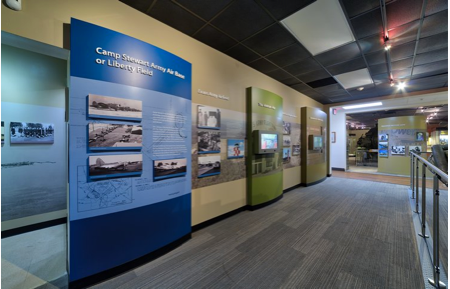
WWII
Events in Europe in 1939-1940 would forever alter the character of the area. In 1939 Hitler invaded Poland. As World War II raged, the US government began greatly increasing military strength and expanded the number of installations.
The Federal government needed an anti-aircraft training camp and established the Camp Stewart Military Reservation for this purpose in 1940-41. The ranges required for anti-aircraft weapons and the numbers of Soldiers scheduled to train at Camp Stewart necessitated the government’s purchasing or condemning more than 279,000 acres of land in Bryan Evans, Liberty, Long and Tattnall counties in Southeast Georgia.
On 1 July 1940 the first 5,000 acres were bought and subsequent purchases followed. Eventually the reservation would include over 280,000 acres and stretch over five counties. The large expanse of property was required for the firing ranges and impact areas which an anti-aircraft artillery training center would need for live fire training.
In November of 1940 the Anti-Aircraft Artillery Training Center was officially designated as Camp Stewart, in honor of General Daniel Stewart, a native of Liberty County who had fought with Francis Marion during the Revolution and became one of the county’s military heroes. An announcement of the new post’s name was made in Jan. 1941.
During the early months, training was done on wooden mock-ups since real anti-aircraft guns were in short supply. Live firing exercises were conducted on the beaches of St. Augustine and Amelia Island, Fl. since the necessary ranges and impact areas had not been completed at Camp Stewart. This live fire training over the ocean continued until Sept. 1941 while at Camp Stewart practice firing and searchlight training progressed.
In Fall of 1941 the Carolina maneuvers were held and all the anti-aircraft units from Camp Stewart anticipated. As these maneuvers drew to a close, a feeling of restless anticipation pervaded the ranks of the National Guard soldiers who were looking toward their impending release from active duty after completion of their year of training. But the Japanese attack on Pearl Harbor on Dec. 7th ended these dreams. Now the U.S. was in the war and Camp Stewart set about accomplishing the mission it was intended for.
The National Guard units departed and new units came in for training. Facilities were expanded and improved. Anti-aircraft artillery training was upgraded and soon a detachment of Women’s Air Service Pilots (WASP’s) arrived at the air facility on post, Liberty Field, to fly planes to tow targets for the live fire exercises. Eventually radio-controlled airplane targets came into use as a more effective and safer means of live-fire practice.
As the war progressed, Camp Stewart’s training programs continued expanding to keep pace with the needs placed upon it. Units were shipped out promptly upon completion of their training and new units received in their place. The camp provided well-trained soldiers for duty in Europe, the Mediterranean, North Africa, and the Pacific theaters.
By late 1943 Camp Stewart assumed a new responsibility as one of many holding areas designated in this country for German and Italian prisoners of war who had fallen into Allied hands during fighting in North Africa. These men were held in two separate prisoner-of-war facilities on post and used as a labor force for base operations, construction projects, and for area farmers.
Beside its initial purposes as an anti-aircraft artillery training center, Camp Stewart also served as a Cook and Bakers School and as a staging area for a number of Army postal units. By Spring 1944 the camp was bulging at its seams as more than 55,000 soldiers occupied the facility during the build-up for the D-Day invasion. However, almost overnight, the post was virtually emptied as these units shipped out for England. With the D-Day invasion and Allied control of the air over Europe, the need for anti-aircraft units diminished and in response the anti-aircraft training at Camp Stewart was phased out. By Jan. 1945 only the prisoner-of-war camp was still functioning.
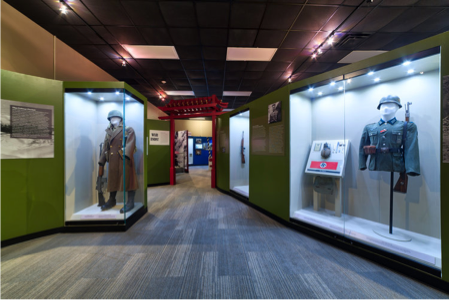
Korean War
With the end of the war, Camp Stewart came to life briefly as a separation center for redeployed soldiers, but on 30 Sept. 1945 the post was inactivated. Only 2 officers, 10 enlisted men, and 50 civilian employees maintained the facilities and the GA National Guard did the only training during summer months. It seemed as if Camp Stewart had served its purpose.
However, once again, world affairs affected the life of Camp Stewart. With the outbreak of hostilities in Korea in June 1950, the U.S. once again found itself with the need to update training and prepare new soldiers to meet the crisis in Korea. Camp Stewart was reopened on 9 August 1950, its facilities repaired and troops brought in for training. On 28 Dec. 1950 Camp Stewart was redesignated as the 3rd Army Anti-Aircraft Artillery Training Center. Intensive training of soldiers destined for service in Korea began. Since control of the air in Korea wasn’t seriously challenged by the Communist forces, in late 1953 Camp Stewart’s role changed from solely anti-aircraft training to include armor and tank firing as well.
When the Korean conflict eventually cooled down, it was recognized that our country would be required to maintain a ready and able military force to deal with any potential threat to the Free World. Camp Stewart would have a role to play in that mission. The decision was made that the post would no longer be viewed as a temporary installation. On 21 March 1956 it was redesignated as Fort Stewart. Its role would continue to evolve in response to specific needs and world events.

Cuban Missile Crisis
In 1959 Fort Stewart was re-designated as an Armor and Artillery Firing Center, since its old anti-aircraft ranges and impact areas were better suited for this purpose than for the new age of missiles. By 1961 there was a feeling that Fort Stewart may have served its usefulness and there was movement afoot to deactivate the post again. However, the age of missiles brought with it new threats and a new place for Fort Stewart.
In late 1962 the U. S. was shocked to discover Russian offensive missiles being placed in Cuba. This revelation eventually lead the world to the brink of war as the two super-powers stood toe-to-toe, each refusing to back away. The U.S. demanded the removal of these missiles and Russia refused to comply. In response to this threat the U.S. military began a rapid mobilization for possible use against Cuba. The 1st Armored Division was ordered to Fort Stewart for staging and in the short span of two weeks the population of the post rose from 3,500 personnel to over 30,000.
The country prepared for the worst, but in the end a compromise was reached, and the crisis passed. Shortly after, word was received at Fort Stewart that a VIP would be visiting the post and that the post conference room wasn’t worthy of a person of this stature. Thus, preparations were rapidly made to convert this conference room into a more suitable one. The command group at Fort Stewart quickly discerned that this VIP would be none other than our nation’s President, John F. Kennedy. He arrived at Hunter Field on 26 Nov. 1962, flew to Donovan Parade Field at Fort Stewart, where he reviewed the entire 1st Armored Division. From there he was taken to the new conference room where he was briefed on armed forces readiness to respond to the Cuban missile crisis, then visited troops in nearby training areas.
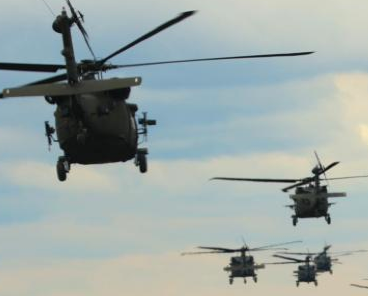
Vietnam War
After the Cuban missile crisis had passed, the Cold War situation kept Fort Stewart in an active training role. During the late 1960’s another developing situation would bring about yet another change in Fort Stewart’s mission. With tensions growing in the divided country of Viet Nam, the U.S. found itself becoming increasingly involved in that conflict.
The Vietnamese terrain and the type of war being fought there demanded an increased aviation capability through the use of helicopters and light, fixed wing aircraft. This brought about a need for more aviators. In response to this need, an element of the U.S. Army Aviation School at Fort Rucker, Alabama was transferred to Fort Stewart in 1966. Helicopter pilot training and helicopter gunnery courses became Fort Stewart’s new mission. In an ironic twist, now instead of training soldiers to shoot down aircraft, they were training soldiers to fly them.
When the Air Force closed their base at Hunter Field in Savannah in 1967, the Army promptly assumed control and in conjunction with the flight training being conducted at Fort Stewart, the U.S. Army Flight Training Center came into being. The helicopter pilot training was rapidly accelerated and pilots were trained and soon sent to duty all over the world, with a large percentage seeing active duty in Viet Nam.
In 1969 President Nixon planned to reduce American involvement in Viet Nam by training the Vietnamese military to take over the war. In conjunction with this, helicopter flight training for Vietnamese pilots began at the Training Center in 1970 and continued until 1972.
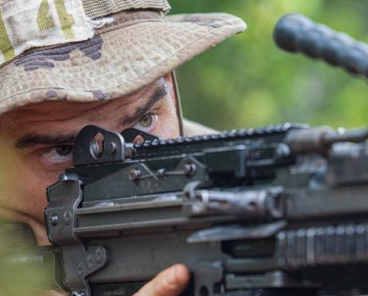
3rd Infantry Division (3ID)
In November 1990, Soldiers of the 3rd Infantry Division were once again called into action. Following Iraq’s invasion of Kuwait, over 6,000 Marne men and women deployed with Operation Desert Storm as part of the Allied Coalition which brought a swift end to Saddam Hussein’s military aggression in the Gulf region. Nearly 1,000 soldiers deployed to southeastern Turkey and northern Iraq to provide comfort to Kurdish refugees. Almost 1000 were part of Task Force Victory, which began the task of rebuilding Kuwait.
A new chapter of Marne history has begun with the designation of the 3rd Infantry Division (Mechanized) at Fort Stewart and Ft. Benning. The units are now at Fort Stewart, Georgia, and Ft. Benning, Georgia, and the Aviation Brigade is at Hunter Army Airfield, Georgia.
Although the Division did not receive battle credit, some units served with other Army groups at the conflicts in Bosnia and Croatia in 2000-2001.
Early in 2003, the fighting capability of the Marne Division was highly visible worldwide when the entire Division deployed to Kuwait. It was called on subsequently to spearhead coalition forces in Operation Iraqi Freedom, fighting its way to Baghdad in early April, which led to the end of the Saddam Hussein government that imposed tyranny over the people of Iraq. During the capture and clearing of the Baghdad Airport, another Medal of Honor was awarded. Paul R. Smith received his medal posthumously for his actions that saved the lives of many American soldiers.
Subsequent tours by the 3rd Infantry Division, led to the eventual establishment of a democratic government in Iraq, though continued efforts have been necessary to maintain it. With the close of combat operations in Iraq, the division moved on to Afghanistan and continued combat operations and training missions (advise and assist) to prepare the Afghan Army and police to take over responsibility for security in a very difficult military and political climate. The division and aviation brigade then redeployed to duty stations in the U.S.
Soon after, the Division answered the call to arms with units deployed to hostile territory in Afghanistan. These advise and assist missions train and prepare the Afghan Army and security forces to take, hold, and occupy large areas of their nation.
The 3rd Division (later re-designated as the 3rd Infantry division on August 1, 1942) was organized at Camp Greene, North Carolina, November 21, 1917. The division was composed of the 4th, 7th, 30th, and 38th Infantry Regiments, the 10th, 18th, and 76th FA Regiments, and the 6th Engineer Regiment, with a total of 28,000 men. It underwent training at Camp Green, North Carolina and Fort Bliss, Texas, and shipped to France, arriving in April 1918. A monument to the origination of the 3rd Infantry Division stands today in Charlotte, North Carolina, at the corner of Wilkinson Blvd., and Monument Street.
The division earned the designation “Rock of the Marne” at the Marne River near Chateau-Thierry on July 15, 1918. When flanking units retreated, then Division Commander, Major General Joseph Dickman, told our French Allies “Nous Resterons La” (we shall remain here). This motto is on the 3rd Infantry Division’s distinctive insignia.
Although the stand was successful, the price was high. General “Black Jack” Pershing said it best when he called the Division’s performance “one of the most brilliant in our military annals.” The division earned six battle stars in WWI. The 3rd Infantry Division Soldiers were awarded two Medals of Honor during WWI.
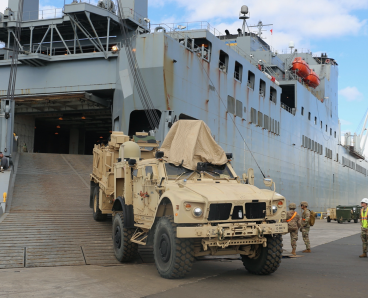
Today
Gradually America’s involvement in Viet Nam dwindled and by mid-1972 the flight training aspect of Fort Stewart’s mission was terminated and both Hunter Field and Fort Stewart reverted to garrison status. The following year Hunter was closed entirely and Fort Stewart sat idle with the exception of the National Guard training which continued to be conducted at the installation.
It appeared as if Fort Stewart had once again reached the end of its usefulness and questions were raised about its status and future. The end of the Vietnam conflict meant a new focus for the U.S. Army, and a new life for several of the Army’s historic units would mean new life for Fort Stewart.
On 1 July 1974 the 1st Battalion, 75th Infantry Regiment (Ranger), parachuted into Fort Stewart and was reactivated the following month. They were the first Army Ranger unit activated since WWII. Hunter Army Airfield was once again reopened to support the training and activities of the Rangers.
In Oct. of 1974 the Headquarters, 1st Brigade of the 24th Infantry Division was activated at Fort Stewart. This historic unit, which had seen active and arduous service in the Pacific during WWII and in the Korean War, had been inactive since 1970. The “Victory” Division, as it was known, was going to make Fort Stewart its home, and it was perhaps fitting that the “V” shaped layout of the main post itself. The 24th Infantry Division would make Fort Stewart uniquely its own.
With the reactivation of the 24th Infantry Division, the post entered a new phase in its history. Facilities were upgraded and new permanent structures replaced many of the old wooden buildings from the days of Camp Stewart. On 1 Oct. 1980 the 24th Infantry Division was designated a mechanized division and assigned as the heavy infantry division of the newly organized Rapid Deployment Force. This designation was the fruition of that potential first realized by those who served at the post during the Cuban missile crisis.
The 24th Infantry Division began intensive training over the expanse of piney woods and lowlands of the post, and conducted live fire exercises on many of the old Camp Stewart anti-aircraft ranges. Additional deployment training and exercises took Division units from GA’s wood-lands to the National Guard Training Center in California, as well as to other area of the world such as Egypt and Turkey. Their training was continuous. The mission of the Rapid Deployment Force was to be prepared to deploy to practically any point on the globe at a moment’s notice to deal with whatever threat might be discerned.
In August 1990, Iraq invaded and overran neighboring Kuwait and threatened to do the same to Saudi Arabia. The Port of Savannah worked around the clock to load and ship the Division’s heavy equipment, while aircraft shuttles from Hunter Field flew the Division’s personnel to Saudi Arabia. Within a month the entire Division had been reassembled in Saudi Arabia to face the possible invasion of that country by Iraqi forces. Fort Stewart saw a growing influx of National Guard and Reserve units who were being mobilized to support the operations in Saudi Arabia and to assume the tasks at the post which had formerly been accomplished by Division personnel. In many ways, Fort Stewart appeared to be almost a ghost town, as never before has the entire Division been deployed from the post at one time. Within eight months the crisis in the Persian Gulf had concluded and the 24th Infantry Division triumphantly returned to its home in coastal GA.
On 25 April 1996 the 3d Infantry Division was activated at Fort Stewart. This began a new chapter in the history of Fort Stewart.
Today, Fort Stewart is one of the Army’s premier installations and has earned the Army Community of Excellence Award an unprecedented six times in 2004, 2005, 2006, 2009, 2012, and 2015.


